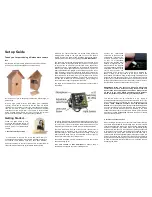
Handbook for the TRIUS PRO-694C Issue 1 September 2020
16
quality achieved, you might like to trim the settings of your par-focal or flip mirror
eyepiece to match the current camera position.
Although you can reach a good focus by the above method, many observers prefer
to use additional aids, such as Hartmann or Bahnitov masks (an objective cover with
several spaced holes) or diffraction bars (narrow parallel rods across the telescope
aperture). These make the point of precise focus easier to determine by creating
‘double images’ or bright diffraction spikes around stars, which merge at the setting
of exact focus. The 12-16 bit slider control allows you to adjust the contrast of the
focus frame for best visibility of the star image. It defaults to maximum stretch (12
bits), which is generally ideal for stars, but a lower stretch value is better for focusing
on planets.
Taking your first astronomical image:
I will assume that you are now set up with a focused camera attached to a telescope
with an operating sidereal drive. If so, you are now in a position to take a moderately
long exposure of some interesting deep-sky astronomical object (I will deal with
planets later). As most drives are not very accurate beyond a minute or two of
exposure time, I suggest that you find a fairly bright object to image, such as M42,
M13, M27 or M57. There are many others to choose from, but these are good
examples.
Use the finder to align on your chosen object and then centre accurately by using the
focus frame and a short exposure of between 1 and 5 seconds. The ’12-16 bit’ slider
in the focus frame allows you to adjust the image contrast if you find that the object
is too faint with a short exposure. Once properly centred and focused, take an
exposure of about 60 seconds, and observe the result. Initially, the image may
appear rather barren and show only a few stars, however, there is a great deal of
data hidden from view. You can get to see a lot of this, without affecting the image
data, if you go to the ‘View’ menu and select ‘Auto Contrast Stretch Image’. The faint
image data will then appear in considerable detail and I think that you will be
impressed by the result!
If you are happy with the image, go to the ‘File’ menu and save it in a convenient
directory.















































